2004 VOLKSWAGEN GOLF PLUS jump start
[x] Cancel search: jump startPage 6 of 541
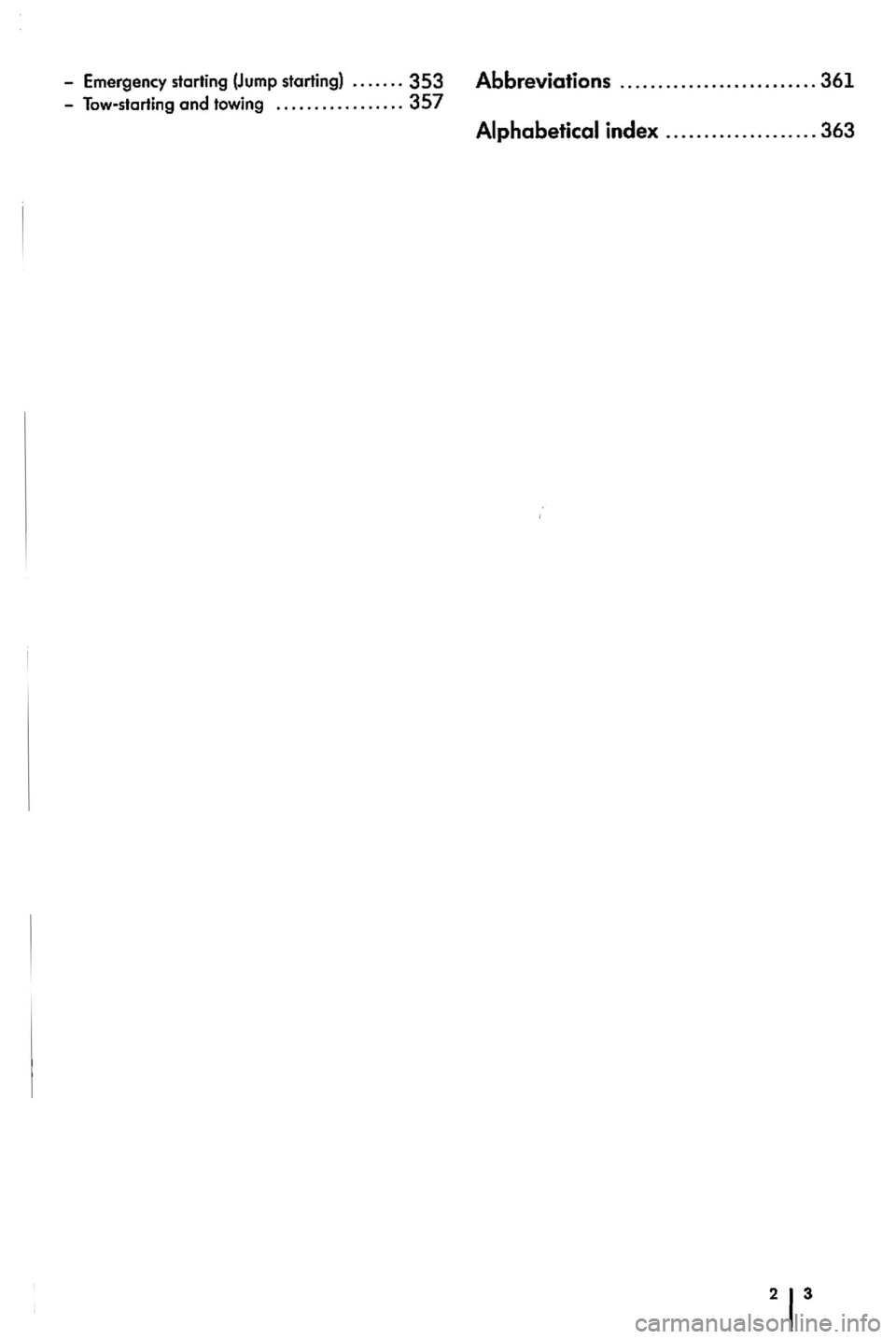
-Emergency starting (Jump starting) ....... 353 Abbreviations .......................... 361 -Tow-starting and towing ................. 357
Page 240 of 541
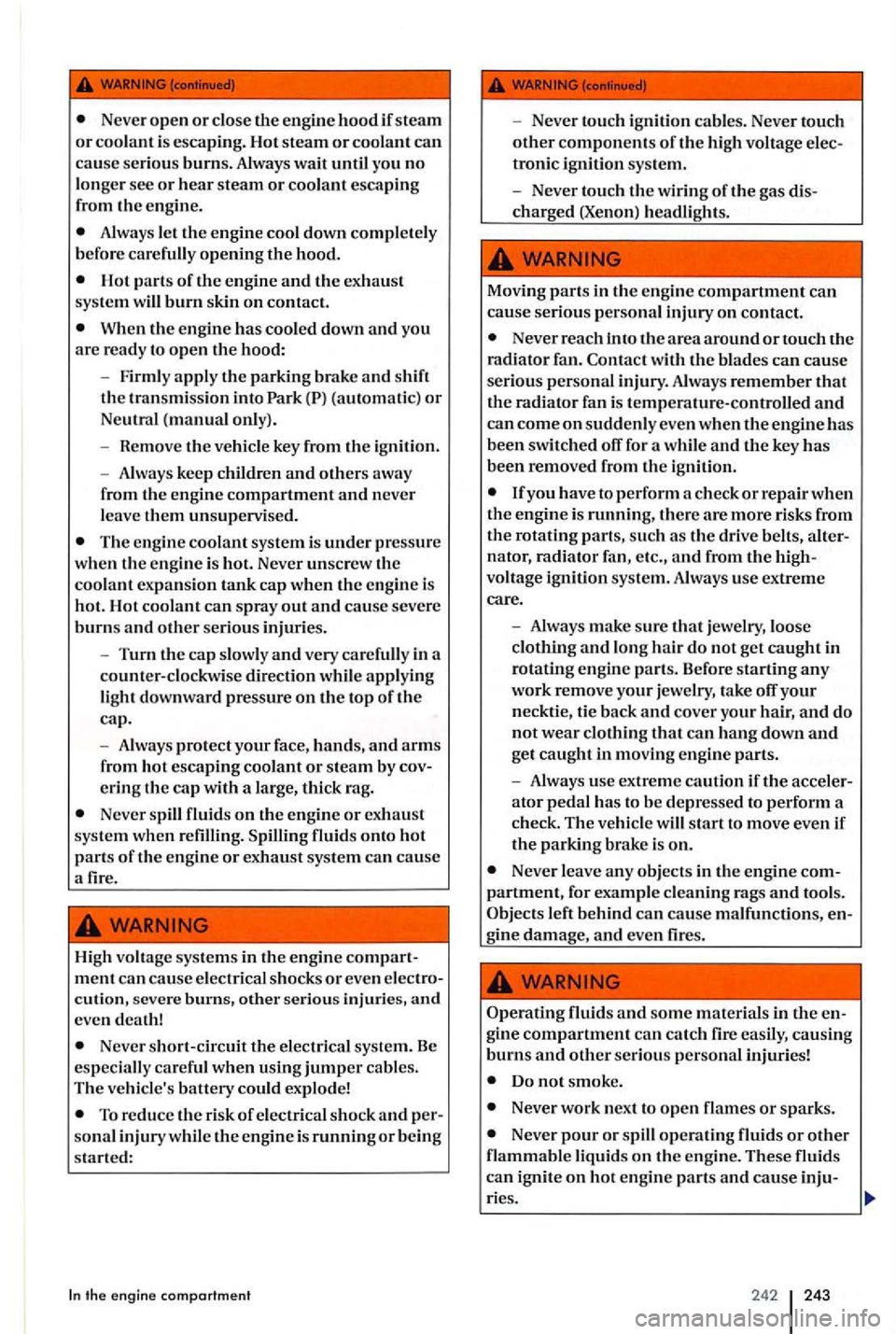
Never open or close the engine hood if steam or coolant is escaping. Hot steam or coolant can cause serious burns. Always wait until you no longer sec or hear steam or coolant escaping
from the engine.
Hot parts of the engine and the exhaust
system will burn skin on contact.
When the engine has cooled down and you are ready to open the hood:
- Firmly
apply the parking brake and shift the transmission into Park
The engine coolant system is under pressure when the engine is hot. Never unscrew the coolant expansion tank cap when the engine is
hot. Hot coolant can spray out and cause severe burns and other serious injuries.
- Turn
the cap slow ly and very carefully in a
counter-clockwise direction while applying
light downward pressure on the top of the cap.
- A
lways protect your face, hands, and arms from hot escaping coolant or steam by
Never spill fluids on the engine or exhaust
system when Spilling fluids onto hot parts of the engine or exhaust system can cause a fire.
High voltage systems in the
engine com ment can cause electrical shocks or even
Never short-circuit the electrical system. Be especially careful when using jumper cables. The vehicle's battery could explode!
To reduce the risk of electrical shock and sonal injury while the engine is running or being started:
the engine compartment
- Never touch ignition cables. Never touch other components of the high voltage tronic ignition system.
- Never touch
the wiring of the gas
Never reach into t11e area around or touch the
radia tor fan. Contact with the blades can cause serious personal injury. Always remember that the radiator fan is temperature-controlled and can come on suddenly even when the engine has been switched for a while and the key has been removed from the ignition.
lfyou have to perform a check or repair when the engi ne is running, there are more risks from tl1e rotating parts, such as the drive belts, nator, radiator fan, etc ., and from voltage ignition system. Always use extreme care.
- Always make
sure that jewelry, loose clothing and long hair do not get caught in rotating engine parts. Before starting any work remove your je welry, take
parking brake is on.
Never leave any objects in the engine
left behind can cause malfunctions,
Do not smoke.
Never work next to open flames or sparks.
Never pour or spill operating fluids or other flammable liquids on the engine. These fluids can ignite on hot en g in e parts and cause ries .
242 243
Page 313 of 541
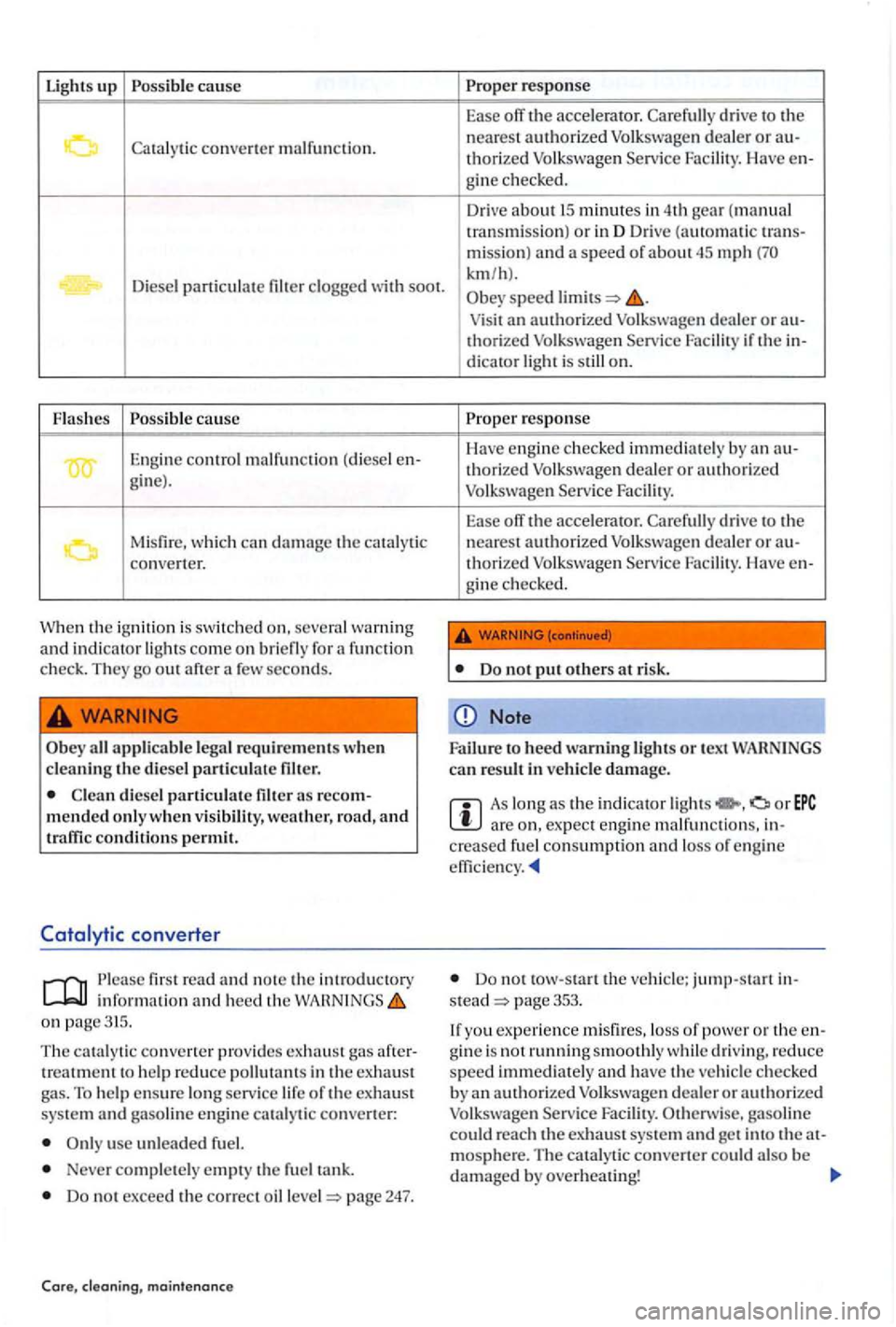
Lights up Possi ble cause
Cata ly tic converte r malfunction.
Diese l particulate
gin e).
Misfir e, whi ch can th e ca talytic
co nve ner.
W he n th e ignit io n is swit ched o n , seve ral warning and indicator lights come o n b riefly for functio n
check. They go out after a few seconds.
a ll applicable legal requirements when cleaning the d iese l p articulate filter .
diesel particula te filt er mended only when v isib ility, we ather, road, and traffic conditions permit.
converter
firs t rea d and not e the introductory inform ati o n and heed the on page315.
The cata lytic con ve rter prov ides exha ust gas treatment to help red uce pollutan ts in the exhaus t
g a s. To help ensure lo ng serv ice life of the exhaus t
sys te m and gaso lin e engine catalytic conv en er:
Neve r comple te ly empty th e fu el tank.
Do not exceed the correct page 247.
mainte nan ce
Prop er response
Ease off the accelerator.
minutes in 4th gear (m anual
transmission) or in D Dri ve (automat ic trans-
m ission) a speed of about45 mph km /h ).
speed
an authorized Volk swage n dealer or au-thorized
deale r or authorized F ac ility.
Ease off the acce lerator. dri ve to the
n earest authorized d ea le r or thori zed Facili ty. Have en-gin e c hecked.
D o not put others at risk.
Note
Failure to heed warning lights or text can result in ve hicl e damage.
As long as the in dicator ligh ts are on , ex pect engin e malfunctio ns, cre ased fuel co nsumption a nd loss of en g in e
efficie ncy.
Do not tow-start the vehicle; jump-start stead page 353.
yo u ex perie nce mi sfires, loss of p ower or th e gin e is not running smoothl y w hile driving. reduce
speed immediately and have the ve hicl e checked by an authorized
Page 314 of 541
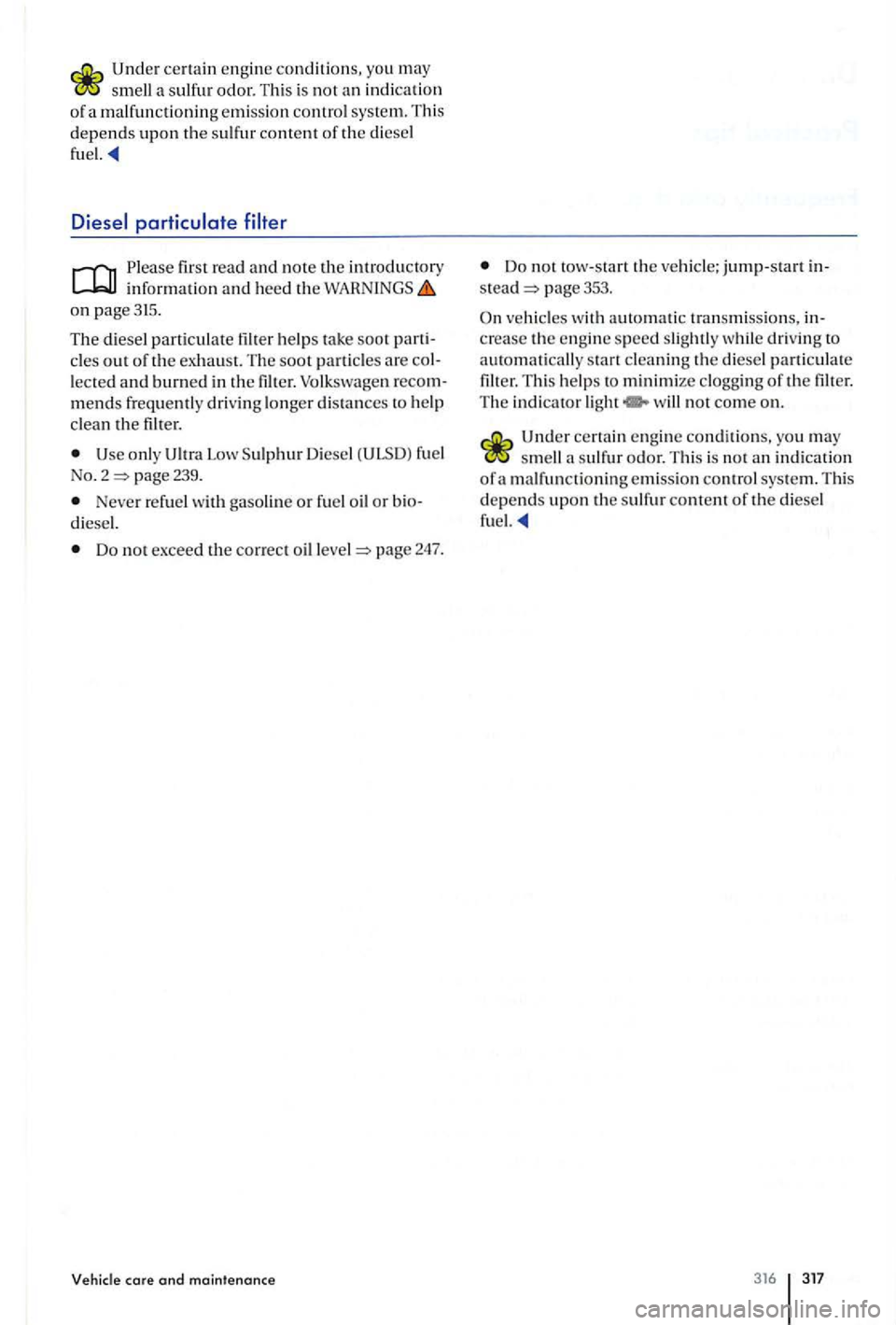
smell a sulfur odor. This is no t a n indica tio n
o f a malfun ctioning emission control system. This depends upon the sulfur content of the diesel
fuel.
first read and note the introd uctory information and heed the on page 3 15 .
The d iesel particulate 11lter help s take soot parti
cle s out of the exhaust. The soot particle s are lected and burned in the filter. Volkswagen recommends frequently driving longer di sta nces to help clean the filter.
onl y page 239.
Never refuel with gasoline or fu el oil or bio
d iesel.
Do not exceed the correct oil level page 247.
core and maintenance
Do no t tow-start th e ve hicl e; jump-start in
s t
ead page 353.
ve hicles wi th automatic transm issio ns, in
c re a se the e ngine speed slig htl y w hil e driv in g to automatically start cleanin g th e diesel partic u la te
filter. Thi s helps to minimize clogging of the filt er. The indicator light will not come on.
certai n engi ne conditions. you m ay sm ell a sulfur odor. This is no t an indicat ion of a malfunctioning emission control system. T his
depends upo n the sulfur content of the diesel
fuel.
3 16 317
Page 315 of 541
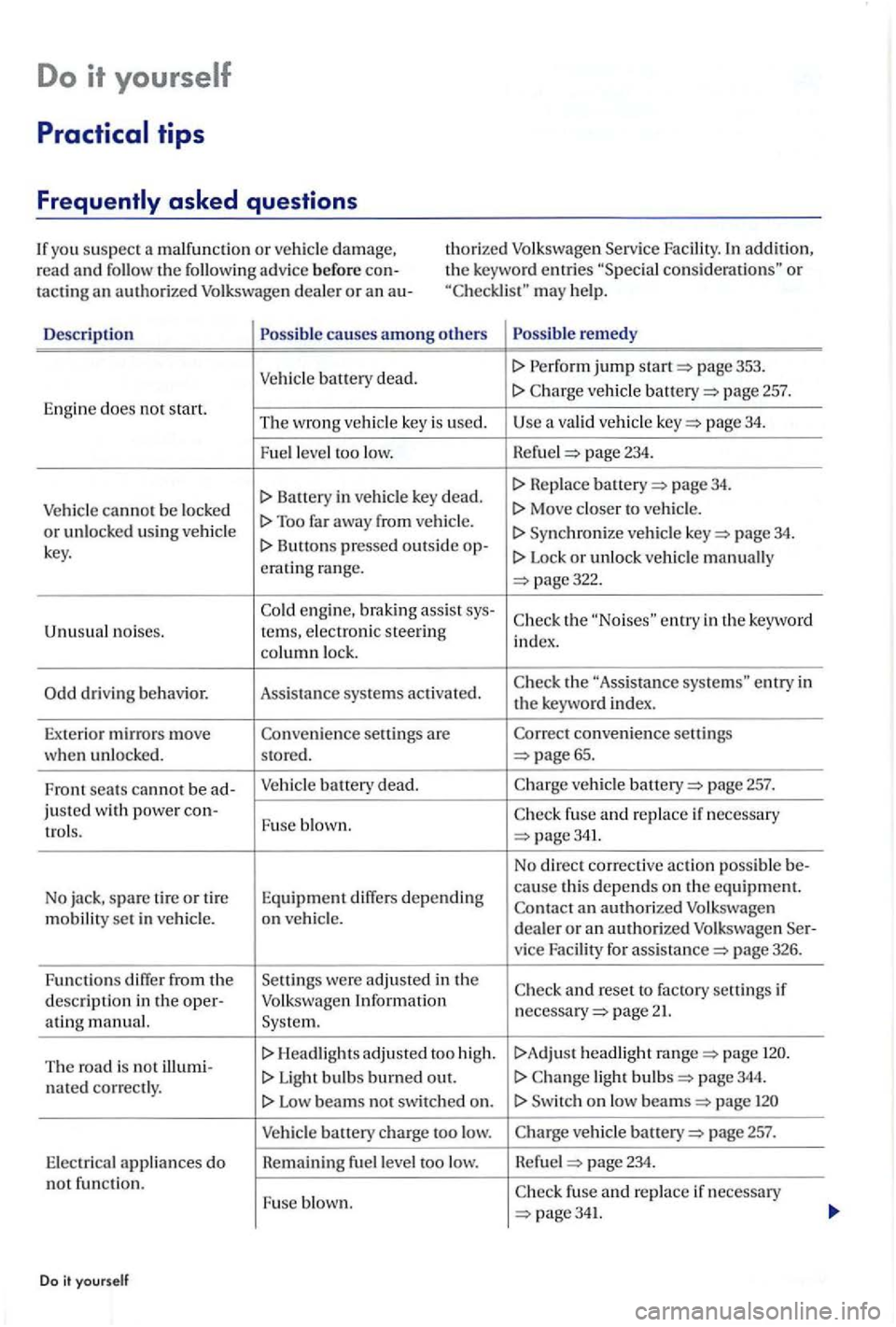
Do it yourself
con sid era tions" or may help.
De
scription causes amon g oth ers remed y
Vehicl e ba tt ery dead. jump page 353.
page 257. Engine does no t start. The wrong ve hicle key is used. a valid ve hicl e page 34.
Fuel leve l too low. Hefue l 234.
Batt ery in ve hicl e key dead. page 34.
Vehicle cannot be locke d Too far away from vehicle . Sy nchroni ze veh icle page 34. key. Lock or unlo ck vehicl e manually
crat ing range. page322.
en gine, braking assis t sys-th e entry in the ke yword noises. te rns, e lectro nic steering index.
co lumn lock.
the "Assis tance e ntry in the keywo rd in dex .
Exterior mirro rs move convenience settings
w he n unl ocke d . stored. 65.
F ront seats can not be ad -Vehicle battery dead. veh icle page 257.
jus ted with power con-Fuse b lown.
a n authoriz e d Volkswage n
m obilit y se t in vehicle. on ve h icl e. dealer or an authori zed Volk swagen Ser-
v ice Facility for page 326.
Func tions diff
er from th e Settin gs were adju ste d in th e and reset to fac tory settings if
descript ion in the oper-Volkswagen Information page 2 ating manual. Syste m.
T he road
is not illumi-H ea dlights a djusted too hig h . !>A dju st headlig ht page
n a ted correctly. Light b ulb s burned out. ligh t page 344.
Low beams no t swi tched on . Switch on low page
Vehicle battery ch a rge too low. page 257.
E lect rica l a p plian ces do Remaining fuel le vel too low. Refu el page 234. not functi on.
page341.
Do it yourself
Page 350 of 541

Emergency starting (Jump starting)
In this section information on the lowing :
Using jum per cables . . . . . . . .
your engin e do es not start because the ve hicl e battery is your ve hicle's ba tt ery nected to th e battery of an oth er ve hicl e to s tart
your eng ine (jump- starting). page 257.
You m ust use jumpe r cables th at m eet rec og ni ze d
indu strial standard s (ch eck inform ation provid ed
b y th e
jumper cabl e manufa cturer). For vehicl es
with gasoline engines , the cross-sec tion of th e jumper cable wire must be at le a st in2 (2 5 or about 3 ga. Fo r v ehicl es with
diesel engines, th e cro ss-section must b e at lea st or abo ut 2 ga.
More information:
Starting assis tance sy s tem s page
Preparations for working in th e e ngin e page 242
Vehicl e page 257
Practical tips
on the batteries or the electrica l system
in your vehicle can cause serious acid burns, fires, or elec trical shock.
Always keep children away from battery acid and vehicle batteries in general.
Sulfuri c battery acid is very corrosive and can
cause blindn ess and damage to unprotected
ski n. Never let battery acid or lead particles
contact your eyes, skin, and clothing.
Never lean over a veh icle battery. Always
wear protective glo ves and eye protection. To reduce your risk of injury, never tilt the batteries;
acid could out through the vents and burn you.
A highly explosive mixture of gases is given
off when the battery is being charged.
Always avoid fires, sparks, open and smoking. Never create sparks or electrostatic
charges when handlin g cable s and electrica l equipment. Never short-circui t the battery nals. High-energy sparks can cause serious
personal injury.
If yo u ge t batt ery acid in your eyes or on your ski n, immediately rinse with cold wate r for
severa l minutes and get attenti on
immediately. If yo u swallow any battery acid,
get medical attention immediately.
Improper use of jumper cables whe n jump-startin g a ve hicle with a dea d battery can cau se th e
battery to exp lode, leading to serio us personal in
jury.
To h elp reduce the risk of battery explo sion :
All work on the batterie s or the ele ctrical
system in your vehicle can cause serious acid
burns, fires, or electrica l shocks. Always read
and heed the following
page 257,
Always make sure that the battery providing
starting assistance (the booster battery) has the same vo lta ge as the dead battery (12 V) and
a b o ut th e same amperage capaci ty (see battery label).
Never jump-start a ve hicl e wit h a frozen battery . The battery can exp lode. A discharged
battery can freeze at temperatures around +32
352 353
Page 351 of 541
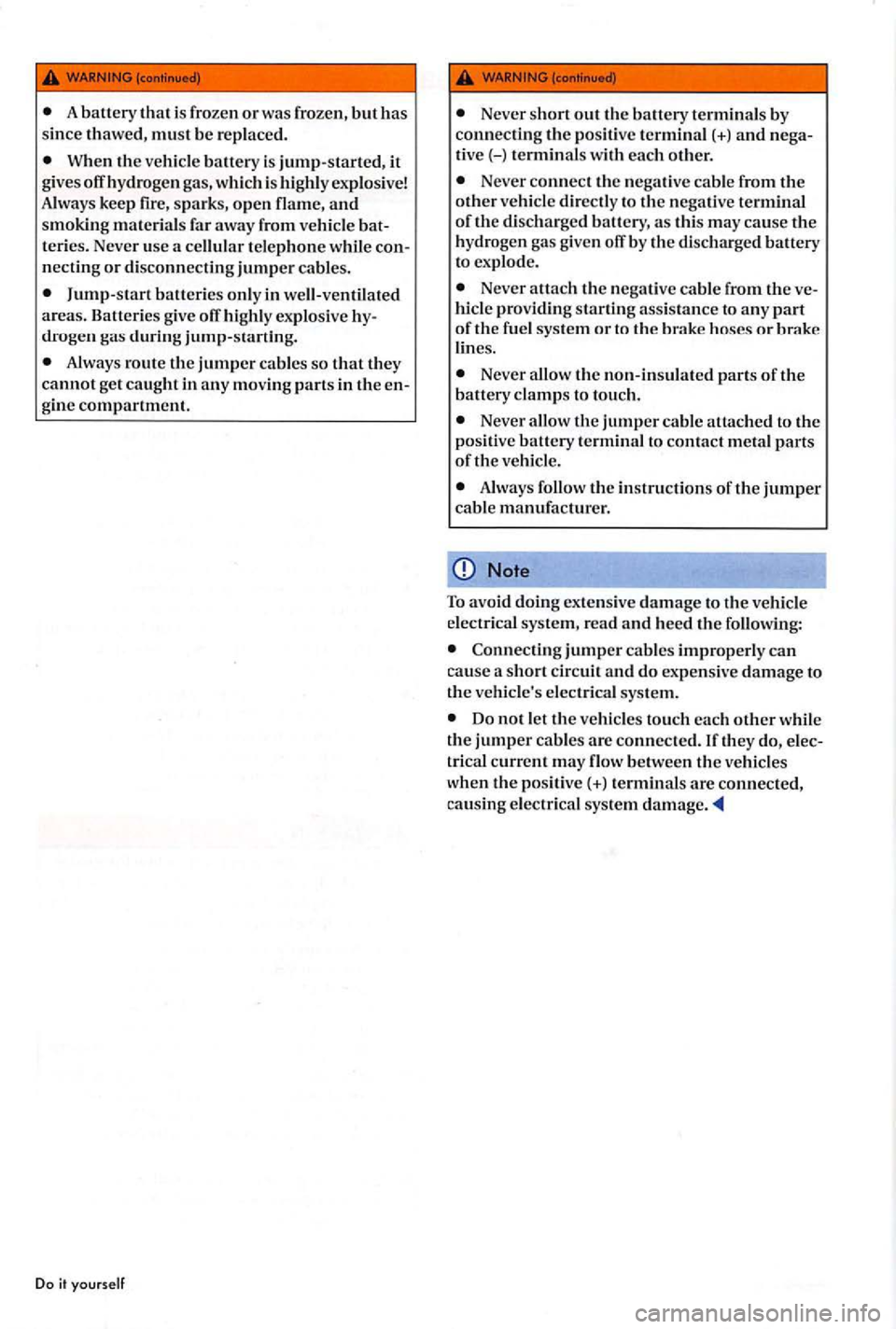
When the vehicle battery is jump-started, it give s off hydroge n gas , which is highl y exp losive!
A lw ays keep fire, sparks, ope n flame , and smoking materi als fa r away from vehicle
necting or disco nnecting jumper cable s.
Jump-s ta rt batterie s only in well-ventil ated
areas. Batteries give off highly explosive
Always route the jumper cables so that they cannot get caught in any moving parts in the
..
Never short out the battery terminals by
connecting the positi ve termina l(+) and
Never connect the negative c abl e from the other vehicle directly to the negativ e terminal of the di scharged b atte ry, as thi s may cause the
hyd rog en gas given off by the di sc harg ed battery
to explod e.
Never att ac h the negati ve cable from the hicl e providing starting assistance to any
Never allow the non-insulat ed parts of the battery clamps to tou ch.
Never allow the jumper cable attached to the
po sitive battery te rminal to contact metal parts of the vehicle.
Note
To avoid doing exte nsive damage to the vehicle
elect rica l system, read and heed t11e following:
Connecting jumper cables imprope rl y can ca use a short cir cuit and do expensive damage to the ve hicl e's electric al sys te m.
Do not le t the ve hicles touch eac h other whil e
the jumper cab les are conncc te d.Iftl1 ey do,
Page 352 of 541
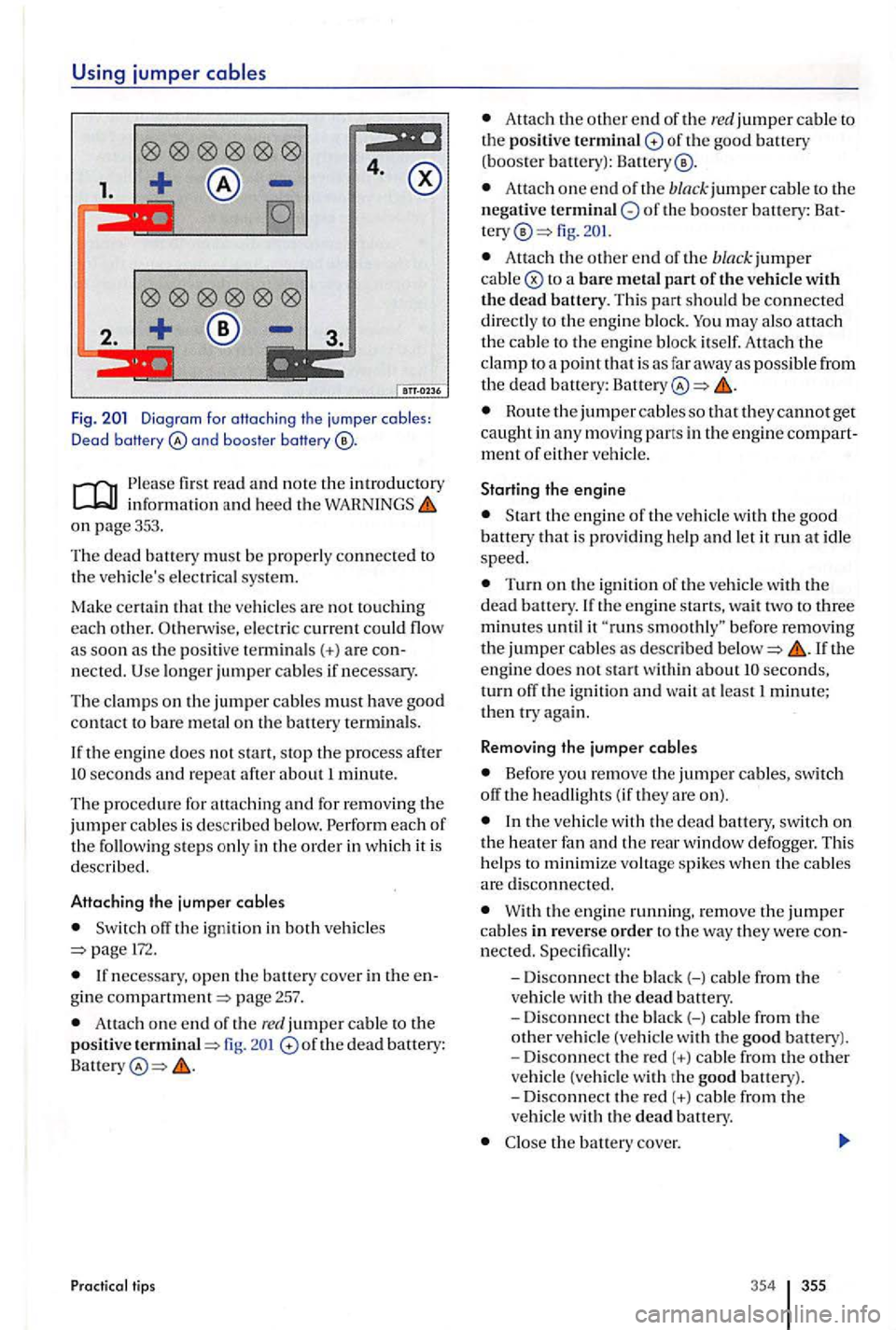
Using jumper
4.
1.
2.
Fig. and boos te r baHery
informat ion and heed the on page 353.
Th e
dead battery must be properly connected to
th e ve hicle's electri cal sys tem.
Ma
ke certain
pos iti ve termin als(+) a re
the engine does not start, stop the process after seconds and repeat after about 1 minute.
Th e procedu re for attach ing
and for removing the jumper cables is desc ribed below.
off the ign ition in both vehicle s 172.
gine compartment=> page 257.
Attach one end o f th e red jumper cable to the positive termina l=> fig. of th e dead battery:
Pr actical tips
Atta ch the o ther end of the re d jumper cable to th e positive terminal of the good battery (booster battery):
Attach one e nd of the black jumper cable to th e
n egative of the booste r battery : fig.
Attac h the oth er e nd of the bla ck jumper cable
may also attach the cable to the e ng in e bl oc k itself. Attach the clamp to a poi nt that is as far away as possible from the dead battery: Battery
Route the jumper cable s so that they cannot get caught in a ny moving pans in th e engine ment of either vehicle.
Starting the engine
is prov idi ng h elp and let it run at i dle speed.
Turn on the ign ition of the ve hicle with the dead battery.
seconds, turn off th e ignition and wa it at least 1 minute; then try again.
Remo ving the jumper cables
Before yo u remove the jumper cables , switch
off the headligh ts ( if they are on).
the ve hicl e w ith the dead battery, switch on the heater fan and the rear window defogger. This
h elp s to minimize voltag e spikes when the cables are disconne cted.
With the engin e running. remove the jumper cable s in reverse order to the way they we re
the bauery cove r.
354 355